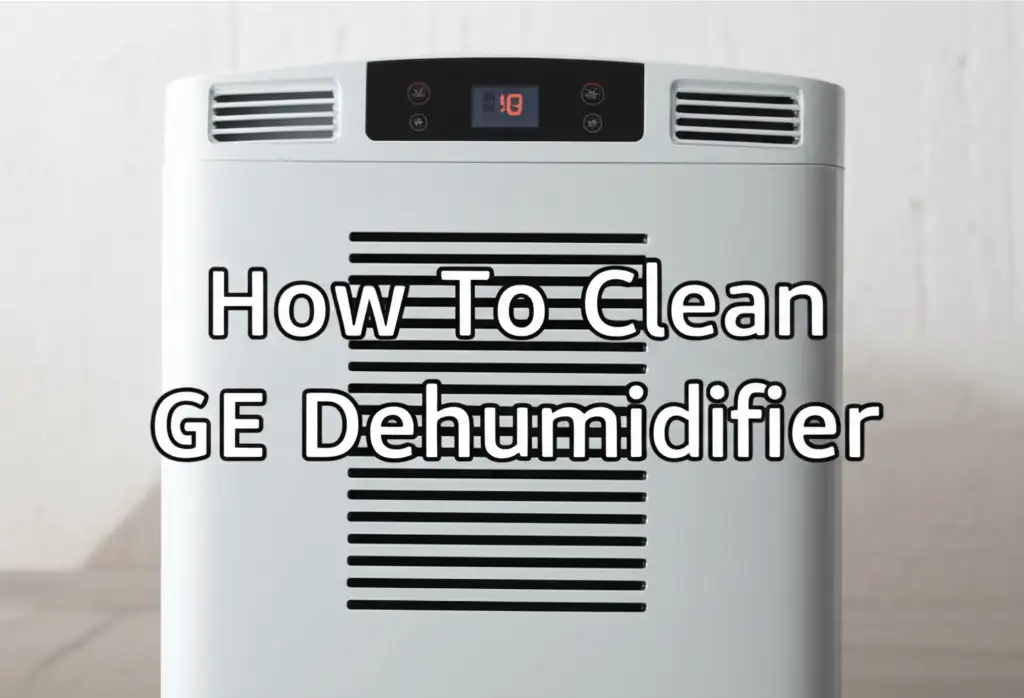· Elira Thomsen · Home Cleaning · 22 min read
How To Clean Ge Dehumidifier

Clean Your GE Dehumidifier: A Simple Guide for Better Air
Imagine a home where the air feels fresh and comfortable, free from that damp, musty smell. Your GE dehumidifier plays a vital role in achieving this, pulling excess moisture from the air. But what happens when the very machine designed to improve your air starts to feel… less than fresh? Over time, dust, dirt, and even mold can build up inside. This reduces its efficiency and can impact your indoor air quality. I know I want my home appliances to work their best.
Learning how to clean your GE dehumidifier properly is not just about keeping it looking nice. It is about ensuring it runs efficiently, prevents mold growth, and provides cleaner air for your family. This comprehensive guide will walk you through each step. You will learn the exact tools you need and the precise actions to take for a thorough cleaning. We will cover everything from the water bucket to the internal coils. Get ready to refresh your dehumidifier and your home environment.
Takeaway
Regularly cleaning your GE dehumidifier ensures its peak performance and longevity. Focus on these key areas:
- Empty and wash the water bucket often.
- Clean or replace the air filter regularly.
- Inspect and carefully clean the coils and fan blades.
- Prevent mold growth by allowing parts to dry completely.
- Follow a consistent cleaning schedule for optimal results.
To clean your GE dehumidifier, disconnect power, then remove and thoroughly wash the water bucket and air filter. Carefully clean the external surfaces, and gently clear dust from the coils and fan blades using a vacuum and soft brush. Ensure all parts are dry before reassembly to prevent mold and maintain efficiency.
Why Cleaning Your GE Dehumidifier Matters for Your Home
Keeping your GE dehumidifier clean is more than just a chore; it is an important part of home maintenance. A clean dehumidifier performs better. It removes moisture from your air effectively, helping to create a healthier living space. Ignoring regular cleaning can lead to several problems that impact both your appliance and your home environment. I always notice a difference in air quality when my appliances are well-maintained.
First, efficiency drops when your dehumidifier is dirty. Dust and debris accumulate on the coils and clog the air filter. This forces the unit to work harder to pull moisture from the air. This increased effort means higher energy consumption and bigger electricity bills for you. A clean dehumidifier runs smoothly and uses less power. Think of it like a car engine; if it is clogged, it will not run efficiently.
Second, a dirty dehumidifier can become a breeding ground for mold and mildew. Dehumidifiers collect water, creating a damp environment inside the unit. If not cleaned, this moisture combines with dust and spores present in the air. This can lead to mold growth within the water bucket, on the coils, and even in the air filter. This mold can then be dispersed into your home’s air, counteracting the very purpose of the dehumidifier. Preventing mold is crucial for a healthy home. You might find this concept similar to how you manage mold in other appliances; for example, understanding how to clean mold off dishwasher provides insights into mold prevention in damp environments.
Finally, regular cleaning extends the lifespan of your GE dehumidifier. Dirt and grime can put a strain on the motor and other internal components. This strain leads to premature wear and tear. By keeping the unit clean, you reduce this stress, helping your dehumidifier last longer. This saves you money in the long run by delaying the need for a replacement. A well-maintained appliance is a happy appliance, and it serves you better.
Essential Tools and Supplies for GE Dehumidifier Cleaning
Before you begin the cleaning process, gathering all the necessary tools and supplies makes the job much smoother. Having everything on hand prevents interruptions and ensures you can complete each step efficiently. Most of these items are likely already in your home, making this a convenient task. I always prepare my tools before starting any cleaning project.
Here is a list of what you will need to effectively clean your GE dehumidifier:
- Phillips Head Screwdriver: This is often needed to remove outer panels or access certain internal components. Check your GE dehumidifier’s manual first; some models might not require tools for basic cleaning. Always use the right size to avoid stripping screws.
- Mild Dish Soap or White Vinegar: These are excellent for cleaning the water bucket and external surfaces. They are gentle yet effective at cutting through grime and inhibiting mold growth. Avoid harsh chemical cleaners, as they can damage plastic parts or leave harmful residues.
- Soft Brush (e.g., old toothbrush, small nylon brush): A soft brush helps scrub away stubborn residue in tight corners of the water bucket. It is also useful for gently cleaning the filter if it is washable. Make sure the bristles are soft to avoid scratching surfaces.
- Vacuum Cleaner with a Brush Attachment: A vacuum is essential for removing loose dust and debris from the air filter, coils, and other internal areas. The brush attachment helps to dislodge dust without damaging delicate components. This is your primary tool for dry dust removal.
- Microfiber Cloths or Soft Rags: These are perfect for wiping down surfaces and drying components thoroughly. They absorb water well and are non-abrasive, preventing scratches. Keep a few on hand for different stages of cleaning.
- Protective Gloves: Wearing gloves protects your hands from dirt, dust, and cleaning solutions. This is especially important if you are dealing with mold or using even mild detergents. Your hands will thank you later.
- Warm Water: You will need warm water for rinsing the water bucket and washing the air filter. A basin or sink filled with warm water will work well for this purpose. Ensure you have access to a clean water source.
Having these items ready will simplify the cleaning process. It helps you get your GE dehumidifier looking and working like new. Proper preparation sets the stage for a successful cleaning session.
Step-by-Step Guide to Cleaning Your GE Dehumidifier’s Water Bucket
The water bucket, also known as the collection tank, is perhaps the most visible part of your GE dehumidifier. It is also the area most prone to mold and mildew growth because it constantly collects moisture. Regular cleaning of this bucket is crucial for maintaining air quality and preventing musty odors. I make sure to clean mine often; it makes a real difference.
Follow these steps for a thorough cleaning of the water bucket:
- Unplug the Dehumidifier: Safety first! Always disconnect the power cord from the wall outlet before beginning any cleaning or maintenance. This prevents accidental starts and protects you from electrical hazards. Never attempt to clean a plugged-in appliance.
- Remove the Water Bucket: Gently slide the water bucket out from the front of your GE dehumidifier. Be careful not to spill any residual water inside. Some models may have a small amount of condensation even if the bucket appears empty.
- Empty Any Remaining Water: Dispose of any water still in the bucket. Pour it down a drain. Do not let it sit, as stagnant water can quickly become a breeding ground for bacteria and mold.
- Rinse the Bucket Thoroughly: Use warm water to rinse the inside and outside of the bucket. This removes loose debris and any slimy residue. A good rinse is the first step to a truly clean bucket.
- Wash with Soap or Vinegar Solution:
- Option A (Mild Soap): Add a few drops of mild dish soap to warm water in the bucket. Use a soft brush or a microfiber cloth to scrub the entire interior surface. Pay close attention to corners and crevices where grime tends to accumulate.
- Option B (White Vinegar): For a more natural and effective mold preventative, create a solution of equal parts white vinegar and warm water. Pour it into the bucket and let it sit for 15-30 minutes. The vinegar helps to kill mold and mildew spores. Then, scrub thoroughly.
- I often use a vinegar solution myself. It really tackles any lingering odors.
- Scrub Stubborn Stains: If you notice any dark spots or persistent slimy film, use your soft brush to gently scrub these areas. Do not use abrasive scrubbers, as they can scratch the plastic. Scratches can create more surfaces for mold to cling to in the future.
- Rinse Again Completely: After scrubbing, rinse the bucket several times with clean, warm water. Ensure all soap or vinegar residue is completely washed away. Any leftover residue could attract more dirt or cause foaming during operation.
- Dry the Bucket Thoroughly: This is a critical step for mold prevention. Use a clean microfiber cloth to wipe the bucket dry, both inside and out. Then, let it air dry completely for several hours before returning it to the dehumidifier. You can place it upside down to help water drain. Ensuring it is bone-dry prevents immediate mold regrowth.
By following these steps, you will ensure your GE dehumidifier’s water bucket is clean, hygienic, and ready to collect moisture effectively. This simple routine goes a long way in maintaining a healthy home environment.
Deep Cleaning the Air Filter: A Critical Step for Your GE Dehumidifier
The air filter is the frontline defense of your GE dehumidifier. It captures dust, pet dander, and other airborne particles before they enter the unit and clog the internal components. A clean filter ensures maximum airflow and efficient moisture removal. Conversely, a clogged filter dramatically reduces efficiency and can even lead to your dehumidifier freezing up. I consider filter cleaning one of the most important tasks.
Regularly cleaning the air filter is paramount. Many GE dehumidifier models feature washable filters, making maintenance straightforward. Knowing how to clean a filter in an old GE dishwasher might give you a similar understanding of the general process for appliance filters. Here is how to deep clean your GE dehumidifier’s air filter:
- Locate and Remove the Filter: The air filter on most GE dehumidifiers is typically located behind a removable grille on the front or side of the unit. Refer to your owner’s manual if you cannot find it. Gently pull or slide the filter out of its slot. Be careful not to shake off excess dust inside the unit.
- Initial Dust Removal (Vacuuming): Take the filter to a trash can or outdoors. Use a vacuum cleaner with a brush attachment to gently suck up loose dust, pet hair, and large debris from both sides of the filter. This preliminary step removes the bulk of the contaminants. This is an important step before any wet cleaning.
- Washing the Filter (If Washable):
- If your GE dehumidifier has a washable filter (check your manual), fill a sink or basin with lukewarm water. Add a small amount of mild dish soap.
- Submerge the filter in the soapy water and gently swish it around. You can use a soft brush or your hands to gently scrub away embedded dirt. Avoid harsh scrubbing or abrasive materials, which can damage the filter material.
- Rinse the filter thoroughly under cool running water until all soap residue is gone and the water runs clear. Make sure no suds remain.
- Drying the Filter Completely: This step is crucial. A damp filter can introduce moisture and promote mold growth inside your dehumidifier.
- Shake off excess water from the filter.
- Place the filter on a clean towel or drying rack in a well-ventilated area. Do not place it in direct sunlight or use a heat source (like a hairdryer) to speed up drying, as this can warp or damage the plastic frame and filter material.
- Allow the filter to air dry completely, which can take several hours. I usually let mine dry overnight to be absolutely sure.
- Reinstall the Dry Filter: Once the filter is bone dry, carefully slide it back into its slot in the GE dehumidifier. Ensure it is seated correctly and the grille is securely replaced.
By regularly cleaning your air filter, you ensure your GE dehumidifier continues to capture airborne particles effectively. It maintains optimal airflow and extends the life of your appliance. A clean filter also helps your unit run more efficiently, saving you money on energy bills. You might wonder how often should you clean your dishwasher filter; similarly, your dehumidifier filter also benefits from regular attention.
Cleaning the Dehumidifier Coils and Fan Blades
While the water bucket and air filter are the most frequently cleaned components, the internal coils and fan blades of your GE dehumidifier also require periodic attention. These parts are critical for the dehumidification process. The coils condense moisture, and the fan draws air over them. Dust and grime accumulating on these components can significantly reduce efficiency and even cause the unit to malfunction. It is a bit more involved, but it is worth it.
Accessing these internal components can vary by GE dehumidifier model. Always consult your owner’s manual for specific instructions on how to remove the outer casing safely. Some models might have easy-access panels, while others require more disassembly. Always ensure the unit is unplugged before attempting to access internal parts.
Here is how to clean the coils and fan blades:
- Unplug and Access Internal Components: Ensure the GE dehumidifier is unplugged from the power outlet. Carefully remove the outer casing or access panel according to your manual. You might need your Phillips head screwdriver for this step. Be gentle with wires and connections.
- Clean the Coils (Evaporator and Condenser):
- The coils resemble a radiator, with many thin metal fins. Over time, dust, lint, and even mold can accumulate on these fins.
- Use a vacuum cleaner with a soft brush attachment to gently vacuum away any loose dust and debris from the surface of the coils. Work slowly and carefully between the fins.
- For more stubborn grime, you can use a can of compressed air. Blast air between the fins to dislodge trapped particles. Hold the can upright to prevent propellant from spraying out.
- If you notice any bent fins, you can gently straighten them using a fin comb (a specialized tool available at appliance stores) or a thin, non-metallic tool like a plastic credit card edge. Straight fins improve airflow.
- Avoid using water or liquid cleaners directly on the coils unless specifically instructed by your manual, as this can damage electrical components or lead to rust.
- Clean the Fan Blades:
- The fan is usually located behind or near the coils. Its blades can accumulate a surprising amount of dust and grime, especially if the air filter has been neglected.
- Use your vacuum cleaner with a brush attachment to remove as much dust as possible from the fan blades.
- For caked-on grime, you might need to gently wipe the blades with a damp microfiber cloth. Ensure the cloth is only damp, not dripping wet. Be extremely careful not to put pressure on the fan motor or wiring. Avoid getting any moisture into the motor housing.
- If the fan assembly is easily removable (check your manual), you might be able to take it out for a more thorough wipe-down. However, often it is fixed.
- Inspect for Mold and Mildew: While cleaning, carefully inspect the coils and fan blades for any signs of mold or mildew. If you find any, you can try to carefully wipe it away with a cloth lightly dampened with a 50/50 white vinegar and water solution. Ensure the area dries completely afterward. Always be cautious when dealing with mold.
- Reassemble the Dehumidifier: Once the coils and fan blades are clean and dry, carefully reassemble the outer casing or replace the access panel. Ensure all screws are tightened and panels are securely fitted.
Cleaning these internal components can significantly improve your GE dehumidifier’s performance. It ensures efficient moisture removal and prevents future operational issues. This deeper cleaning should be done less frequently than filter and bucket cleaning, perhaps once or twice a year, depending on usage and air quality.
Preventing Mold and Mildew in Your GE Dehumidifier
Mold and mildew are common nuisances in damp environments, and your GE dehumidifier, by its very nature, creates such conditions. Preventing their growth is essential for maintaining a healthy home environment and ensuring your dehumidifier operates efficiently. A moldy dehumidifier defeats its own purpose by potentially releasing spores into your air. I learned this the hard way once!
Here are key strategies to prevent mold and mildew from taking hold in your GE dehumidifier:
- Empty the Water Bucket Regularly: This is the most crucial step. Never let stagnant water sit in the collection bucket for extended periods. Even if the bucket is not full, empty it every few days, especially if the dehumidifier runs frequently. Stagnant water is a prime breeding ground for mold and bacteria. If you use the continuous drain option, still check the bucket periodically for any buildup or blockages.
- Clean the Water Bucket Frequently: Beyond just emptying, make it a habit to wash the water bucket with a mild soap and water solution or a white vinegar solution at least once a month. This removes the invisible biofilm that mold spores can cling to. As discussed earlier, drying the bucket completely after washing is equally important. Mold needs moisture to grow, so eliminating standing water is paramount.
- Ensure Proper Air Circulation Around the Unit: Place your GE dehumidifier in an area where air can circulate freely around all sides. Avoid placing it directly against a wall or in a tight corner. Adequate airflow helps prevent moisture from accumulating on the exterior surfaces of the unit, reducing the chance of mold starting there.
- Regularly Clean the Air Filter: A clogged air filter restricts airflow, which can lead to increased humidity within the unit itself. This creates a more favorable environment for mold growth. As detailed in the previous section, clean your filter every few weeks, or more often if you have pets or a dusty environment. A clean filter allows air to move freely, keeping the interior of the dehumidifier drier.
- Allow the Dehumidifier to Dry Out Before Storage: If you plan to store your GE dehumidifier for an extended period (e.g., during winter), perform a thorough cleaning before putting it away. Crucially, let it run for a few hours in a dry room after emptying the bucket and cleaning the filter. This helps to dry out any internal condensation on the coils and inside the casing. Storing a damp unit guarantees mold growth.
- Use a Dehumidifier with an Auto-Defrost Feature (If Applicable): Some GE dehumidifiers come with an auto-defrost function, which helps prevent ice buildup on the coils in cooler temperatures. Ice buildup can also contribute to excessive moisture inside the unit once it melts. This feature helps maintain drier internal conditions.
- Consider Using a Continuous Drain Option: If your GE dehumidifier has a continuous drain option, use it. This feature allows the collected water to drain directly into a floor drain or sink via a hose. This eliminates the need to empty the bucket, significantly reducing the opportunity for mold to grow in standing water.
By consistently applying these preventive measures, you can keep your GE dehumidifier free from mold and mildew. This ensures it continues to improve your indoor air quality effectively and lasts longer. A proactive approach to maintenance keeps your home healthy and your appliances performing at their best.
Post-Cleaning Steps and Maintenance Tips for Your GE Dehumidifier
You have just put in the effort to thoroughly clean your GE dehumidifier. Now, it is time to reassemble it and think about ongoing maintenance. Proper post-cleaning steps ensure your unit is ready to perform optimally, and consistent tips help extend its life and efficiency. I always feel a sense of accomplishment after a deep clean.
Here are the final steps after cleaning and essential maintenance tips:
Post-Cleaning Steps
- Reassemble All Components: Carefully reinsert the thoroughly dried air filter into its slot. Ensure it clicks into place if your model has a locking mechanism. Then, slide the clean and dry water bucket back into the unit. If you removed any outer panels or grilles, reattach them securely, tightening any screws. Double-check that everything is properly aligned before proceeding.
- Plug In and Test the Dehumidifier: Once everything is reassembled, plug your GE dehumidifier back into a grounded electrical outlet. Turn the unit on and set it to your desired humidity level or continuous operation. Listen for any unusual noises and observe its performance. You should notice air flowing freely and the unit quietly starting to collect moisture.
- Monitor Initial Performance: For the first few hours after cleaning, keep an eye on the unit. Check if the water bucket is collecting water as expected. Notice if there are any strange odors; a clean unit should smell fresh, not musty. This initial monitoring helps confirm that the cleaning was successful and all parts are working correctly.
Ongoing Maintenance Tips
Beyond the deep cleaning you just performed, regular, simpler maintenance practices will keep your GE dehumidifier in top shape. Consistency is key here.
- Regular Water Bucket Emptying: Make it a daily or every-other-day habit to empty the water bucket, especially during peak humidity seasons. Do not wait for the “bucket full” indicator if you want to be proactive about mold prevention. This simple act prevents stagnant water from fostering mold growth.
- Frequent Air Filter Checks and Cleaning: Check your air filter every two to four weeks. Depending on how quickly it accumulates dust, either vacuum it or wash it if it is a washable type. A clean filter is the most impactful factor for efficiency. Just like knowing how often should you clean your dishwasher filter affects your dishwasher’s performance, the same applies to your dehumidifier.
- Wipe Down Exterior Surfaces: Use a damp, soft cloth to wipe down the exterior of your GE dehumidifier periodically. This removes dust and dirt that can accumulate on vents and surfaces. This keeps your appliance looking good and helps prevent dust from entering the unit.
- Check for Unusual Noises or Odors: Pay attention to your dehumidifier’s sounds and smells. Any new grinding, rattling, or squealing noises could indicate a problem with the fan motor or other internal components. A persistent musty odor even after cleaning might suggest mold is growing in an inaccessible area or that the humidity levels are still too high. Addressing these issues promptly can prevent more serious problems.
- Ensure Proper Placement: Always maintain adequate clearance around your dehumidifier for optimal airflow. Keep it away from walls, furniture, or drapes that might block the air intake or exhaust vents. Good airflow is essential for efficient operation and prevents the unit from overheating.
- Store Properly During Off-Season: If you only use your GE dehumidifier seasonally, perform a thorough cleaning before storing it. Ensure all internal components are completely dry to prevent mold and mildew during storage. Store it in a dry, protected area.
By following these post-cleaning steps and incorporating these regular maintenance tips into your routine, your GE dehumidifier will continue to operate efficiently. It will provide a comfortable and healthier environment in your home for years to come. Investing a little time in maintenance saves you money and hassle in the long run.
FAQ Section
How often should I clean my GE dehumidifier?
You should empty and rinse the water bucket weekly. Clean the air filter every two to four weeks. A more thorough cleaning, including the coils and internal components, should be done at least once every six months, or more frequently if your home is very dusty or humid. Regular cleaning ensures efficiency and prevents mold.
Can I use bleach to clean my dehumidifier?
It is generally not recommended to use bleach. Bleach can be too harsh for some plastic components and may leave a strong odor. Instead, opt for mild dish soap or a solution of white vinegar and water (equal parts). These are effective at killing mold and mildew without damaging your GE dehumidifier.
What if my GE dehumidifier still smells after cleaning?
If a musty smell persists, it usually indicates residual mold or mildew. Re-clean the water bucket and filter thoroughly. Then, consider a deeper clean of the coils and fan blades, as mold can cling there. Ensure all parts are completely dry before reassembly. Sometimes, running the unit with a vinegar solution in the bucket can help circulate it.
How do I know if my dehumidifier filter needs cleaning?
You will notice a visible layer of dust, pet hair, or debris on the filter. Your GE dehumidifier might also become less efficient at removing moisture, run more constantly, or make louder noises. A clean filter allows air to pass through easily. Visually checking it every few weeks is the best way to tell.
Is it normal for mold to grow in a dehumidifier?
Unfortunately, due to the damp environment, it is common for mold or mildew to attempt to grow in a dehumidifier if not regularly maintained. Dehumidifiers collect moisture, which is a key ingredient for mold growth. However, with consistent cleaning, especially of the water bucket and filter, you can effectively prevent mold from taking hold.
Conclusion
Keeping your GE dehumidifier clean is more than a simple chore; it is an essential practice for maintaining a healthy and comfortable home. Throughout this guide, we have explored why this cleaning matters. A well-maintained GE dehumidifier operates more efficiently, saves you money on energy bills, and, most importantly, provides superior air quality by preventing mold and mildew. I hope this detailed walkthrough makes the process feel much easier for you.
From the weekly routine of emptying and washing the water bucket to the crucial monthly attention given to the air filter, every step contributes to the longevity and performance of your appliance. We also covered the deeper, less frequent cleaning of the internal coils and fan blades, which are vital for sustained efficiency. Remember the critical rule: always ensure components are completely dry before reassembling. This single step is a powerful defense against mold.
By following these straightforward steps, you will extend the life of your GE dehumidifier and ensure it continues to effectively manage your home’s humidity levels. Embrace this cleaning routine as an investment in your home’s air quality and your family’s well-being. A little effort goes a long way. Make it a habit to clean your GE dehumidifier regularly, and enjoy the fresh, crisp air it helps create in your living space.





